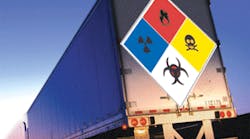The Transportation Security Administration (TSA) has published a final rule that establishes the fees the collection and transmission of fingerprints, as well as separate TSA and FBI (Federal Bureau of Investigations) threat assessment.
In circumstances where the applicants are in states that have a TSA agent collect and transmit fingerprints, the total fee will be $94. Currently 34 states have contracted a TSA agent, while the other states have opted to collect and transmit the information on their own.
See Contractor gearing up for TSA fingerprinting.
There are three components to the total fee: an information collection and transmission fee, TSA’s threat assessment fee, and an FBI background check fee.
The information collection and transmission fee will be $38 for applicants in states that have a TSA agent. However, states that don’t have a TSA agent will establish their own state fee.
TSA’s threat assessment fee will be $34, regardless of whether or not a state has contracted a TSA agent for data collection and transmission.
The FBI background check fee will be $22 for applicants in states that have a TSA agent. For applicants in states without a TSA agent, there may be an additional fee of up to $2 for handling costs.
According to Deirdre O’Sullivan, TSA spokesperson, it is expected to take “several weeks” to perform the necessary background checks. If an applicant is determined to be a security threat, that person may opt to undergo a redress process to appeal that status.
“To set up an appointment for fingerprint collection, the applicant should contact the state-- the same way they would go through the CDL process,” O’Sullivan told Fleet Owner, adding that fingerprint collection locations and payment options also will vary by state.
TSA expects the fingerprint background check rule for hazardous materials endorsements will affect 2 million applicants over the course of five years.
The final rule was published in the Federal Register on Jan. 13, [RIN 1652-AA33].



